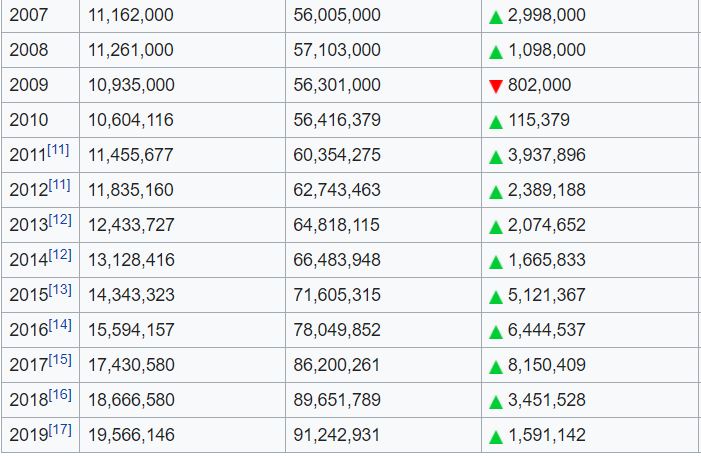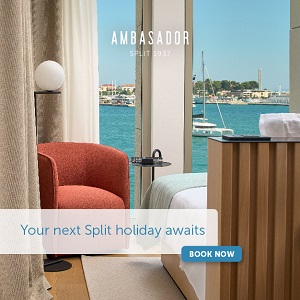ETC's Marketing Group to Hold Annual Meeting in Croatia Next Year
ZAGREB, November 29, 2020 - The annual meeting of the European Travel Commission's (ETC) market intelligence and marketing group will be held in Croatia in April next year, the Croatian Tourist Board (HTZ) announced in a statement earlier this week following the 100th ETC general meeting.
HTZ director Kristjan Stancic attended the meeting, which was held online, in his capacity as ETC vice-president.
The HTZ highlighted the importance of next year's ETC meeting in Croatia for the promotion of the national tourist industry and for strengthening cooperation with European counterparts.
"We expect that the meeting in April will bring together about a hundred marketing and market research experts as well as the heads of the national travel organisations of the ETC member states," Stanicic said, adding that this was a great recognition for Croatia.
He said that the general meeting focused on the post-pandemic recovery of the tourist industry, the importance of implementing healthcare and hygiene protocols, and the promotion of tourism and tourism products through joint promotional campaigns.
"In the time ahead the ETC will promote sustainability, climate-neutral travel and travel aimed at reducing greenhouse gas emissions. It also underlined the importance of establishing a common European travel protocol to facilitate travel and include tourism in national recovery plans," Stanicic said.
The ETC has four representative offices overseas - in China, Canada, the United States and Brazil - and is planning to open two more - in Japan and Australia.
Franka Gulin, the director of the HTZ office in China, has been appointed vice-president of the ETC office in China. She stressed the importance of China for Europe's tourist industry.
"The ETC has big plans on the Chinese market in the coming years, especially in the context of promoting Europe as a tourist destination. I am very glad that, as part of the leadership of the ETC office in China, I will have the opportunity to even more strongly represent the interests of our country on the large Chinese market, which will be the most potent in the post-pandemic period," Gulin said.
PM Has No Symptoms, Working in Self-Isolation - Says Gov't Official
ZAGREB, November 29, 2020 - The head of the prime minister's office, Zvonimir Frka-Petesic, said on Sunday PM Andrej Plenkovic was self-isolating from his wife, who has coronavirus, and their children, adding that he had no symptoms, was continuing to do his job and that the government was working normally.
Plenkovic has been self-isolating since Saturday, when his wife tested positive. His test came back negative.
"The government is working normally. This morning we had two meetings via video link," Frka-Petesic told the press.
He said the prime minister would participate in Monday's cabinet meeting via video link and that as far as he knew, nothing would be cancelled and that all meetings would be virtual.
Asked if the prime minister would get tested again, he said he would when epidemiologists decided that it was necessary.
Vukovar incident condemned
Frka-Petesic also commented on an incident which occurred in a Vukovar bar in the early hours of Saturday, involving the state secretary at the Veterans Ministry, Stjepan Sucic, who violated anti-COVID measures.
"Of course we condemn such an unfortunate event. We regret that something like that happened at a time when epidemiological measures have been prescribed for all of us. There can be no excuse for violating them, notably by government officials who must lead by example," he said, adding that the cabinet would discuss the matter on Monday and "adopt the appropriate decisions."
Asked if Sucic would be sacked, Frka-Petesic it would be considered tomorrow.
He denied that the government had intervened with the Vukovar police station last night. "I know nothing about that. This is a very suggestive question. I don't believe something like that is possible."
Police found Sucic and several other persons in a Vukovar bar in the early hours of Saturday, just after a ban on the work of hospitality establishments went into force. County police said yesterday that two men were arrested for disorderly conduct. Media reported that one of them was Sucic and the other the director of the Homeland War Memorial Centre in Vukovar, Krunoslav Seremet.
Rab Archaeological Traces: Free Application of Rab Island Heritage
November 29, 2020 – In untouched island landscapes, the Rab Archaeological Traces mobile application will present valuable archaeological, sacral, and ethnographic heritage dating from prehistory to the beginning of the 20th century.
As Turizam24 reports, the mobile application Rab Archaeological Traces is an upgrade of the same project, which was initiated within the Program Route 27 Neighborhoods (Programski pravac 27 susjedstava), a part of the Rijeka 2020 – European Capital of Culture project. The app will be presented online on Monday, November 30, 2020, at 2 pm on Facebook.
Starting from the idea of an open-air museum, the Rab Archaeological Traces project was developed, which presented about 30 archeological sites on the island of Rab. In the first phase of the project, which was presented to the public in June this year, three educational trails with a total length of 40 km were arranged, which connected more than 30 archaeological, sacral, and ethnographic sites hidden in untouched island landscapes.
In the second phase, an interactive mobile application was created as a kind of trail guide that combines navigation, augmented reality (virtual characters), audio and video content, various interesting facts, question marks, games, and AR photography, and has built-in statistics and a reward system.
The sites are presented at 34 info points connected by educational trails with a total length of 40 km that stretch through Kampor (Capo Fronte trail), Lopar (Epario trail), and Supetarska Draga (Frux trail) and include protected areas of the landscape. Some sites are in the archaeological strata and you will have to look for them more closely, while others impress with their structures that have defied time for centuries.
In addition to navigation and information about heritage sites themselves, the application also provides many interesting facts, legends, and stories about the island and life on the island. Virtual characters who tell historical stories, audio guides, augmented reality, learning through games, and quizzes will make your exploration of the island unforgettable.
The application works offline and is intended for hikers, cyclists, mountaineers, and all lovers of nature and cultural heritage.
It is free for end-users and can be used for individual exploration of the island, for educational purposes, and as an aid to tourist, bike, and mountain guides during guided tours.
The application was developed by the Lopar Cultural Center, Rab Public Open University, Rab Tourist Board, and Lopar Tourist Board with the expert assistance of the Institute of Archeology and the Maritime and Historical Museum of the Croatian Littoral Rijeka, and financial support from the City of Rab and Lopar Municipality.
For the latest travel info, bookmark our main travel info article, which is updated daily.
Read the Croatian Travel Update in your language - now available in 24 languages.
Croatian Water Polo Cup: Final Four Teams Determined
November 29, 2020 - The final four teams have been determined in the Croatian Water Polo Cup finals, which will be played in January.
Mladost Zagreb defeated OVK POŠK in the last round of the Croatian Cup qualifiers 15-6 (3-0, 4-1, 3-3, 5-2) and thus once again confirmed the leading position in group A, while Jug AO and Primorje EB secured the top spots in Group B.
The best scorer of the match between Mladost and POŠK was Mislav Vrlić who scored four goals. Thanks to a well-played qualifying tournament without a defeat, Mladost imposed itself as one of the strongest opponents in the upcoming Final Four of the Croatian Cup, which will be played on January 23 and 24, 2021.
"I think we achieved the ultimate goal, which is to be first in the group, which allows us to have an easier opponent in the Croatian Cup finals. The tournament itself was done really well. I would especially like to refer to the match against Jadran, which was our direct rival in the fight for first place. I think that we functioned like a Swiss watch and although Jadran showed strength and fighting spirit, we were a better opponent and deservedly achieved first place in the group," said Mladost coach Zoran Bajić.
In Dubrovnik, VK Jug AO beat VK Primorje 13-4, while EB Solaris defeated KPK 21-1. Despite the defeat, Primorje EB took second place in qualifying group B, and Solaris failed to achieve a place in the Final Four despite a big victory, and thanks to the goal differential.
Rijeka will be a host in the Final Four as Primorje EB managed to qualify for the final tournament.
The semifinal pairs are as follows: Mladost - Primorje EB and Jug Adriatic osiguranje - Jadran. The final tournament will be played on January 23 and 24, 2021.
Qualification Group A:
OVK Pošk - HAVK Mladost 6-15 (0-3, 1-4, 3-3, 2-5)
Medveščak - Mornar 6-14 (0-1, 1-4, 1-6, 4-3)
1. HAVK Mladost 4 4 0 0 65:24 +41 12
2. VK Jadran Split 4 3 0 1 62:30 +32 9
3. VK Mornar BS 4 2 0 2 33:45 -12 6
4. VK Medveščak 4 1 0 3 34:62 -28 3
5. OVK POŠK 4 0 0 4 22:55 -33 0
Qualification Group B:
Galeb MR - Zadar 1952 12-8 (5-3, 2-1, 2-1, 3-3)
Primorje EB - Jug AO 4-13 (0-4, 0-3, 1-4, 3-2)
Solaris - KPK 21-1 (2-0, 7-0, 3-0,9-1 )
1. VK Jug AO 5 5 0 0 95:26 +69 15
2. VK Primorje EB 5 3 1 1 72:34 +38 10
3. VK Solaris 5 3 1 1 72:36 +36 10
4.VK KPK 5 2 0 3 45:74 -29 6
5.VK Galeb MR 5 1 0 4 36:84 -48 3
6. VK Zadar 1952 5 0 0 5 27:93 -66 0
Source: HRT
To read more about sport in Croatia, follow TCN's dedicated page.
What do Croatian Tourism Seasons 1980, 2010 & 2020 Have in Common? They Were the Same
November 29, 2020 - As the global tourism industry is forced into a rethink due to the pandemic, some interesting comparisons and contrasts between Croatian tourism seasons from 1980 to 2020.
If there has been anything positive about this disastrous year, it is perhaps that the chaos unleashed by the coronavirus pandemic has forced us all to take a closer look at our lives, and to reassess where things could perhaps be done differently in order to adapt to new realities.
Nowhere is that more true than in tourism. Who remembers that buzzword of the 2019 season - overtourism? Is it a word which will ever be used again, or will it go down in Wikipedia as a unique tourism phenomenon in the 2018-9 era to describe a strange human obsession to pack themselves into confined spaces like sardines in the name of tourism?
The Kingdom of Accidental Tourism had a better season than many - including me - predicted. While it has been amusing to see our official tourism heroes claim all the credit for this relative success, small factors such as Croatia having essentially the only open driveable coastline for the markets of Central and Eastern Europe perhaps played a small role. Just ask Dubrovnik, not quite a driving destination, which registered just 12% of its 2019 tourism traffic for the first six months of the year until UK flights started in earnest. And the 110,000 Slovenian owners of holiday homes in Croatia presumably were able to find their way to their pads on the Adriatic after weeks of lockdown without the need for persuasion.
I digress.
The Croatian National Tourist Board seems to have unveiled a new strategy (actually, perhaps rather than saying 'a new strategy', that should read 'a strategy') for the 2021 season, and I am heartened that at least part of it appears to be based on a slogan I have been suggesting for a while - Croatia, Your Safe, Authentic, Lifestyle Destination. Director Stanicic in the Croatian media this week:
At this point, it is certain that the issue of the coronavirus pandemic will mark next year as well, with the safety factor being one of the basic preconditions in making the final decision on travel. We will focus our future activities even more strongly on digital promotion channels and social networks with a focus on the nearest European markets where Croatian destinations are easily accessible by road, such as Germany, Slovenia, Austria, Poland, Czech Republic, Italy, Hungary, etc. that in the future we expect the growth of domestic tourism in the overall result, we plan a stronger promotion of tourism and special tourism projects intended for domestic guests
The focus on regional tourists certainly makes sense, as this is one of Croatia's key (and accidental) competitive advantages - with flights so uncertain in general, tourists from these markets have few other reliable options. It is a good job we have a national tourist board, 20 regional tourist boards, 319 local tourist boards, a Ministry of Tourism, as well as those tourism chaps from the Chamber of Economy (whatever they do) to take credit for all this.
But for all this talk of regional markets, no mention at all about some of the closest and most loyal markets to Croatia - the countries of former Yugoslavia, with the notable exception of Slovenia.
In the 2020 spirit of having a fresh look at all aspects of life, I decided to look back at previous tourism trends and numbers to see if there was anything we could learn. And what I found REALLY surprised me.
Was 2020 really a disaster for Croatian tourism? Actually, if you judge it by the only currency the Kingdom's tourism gurus recognise - numbers, numbers, numbers - it was not a disaster at all. Thanks to those drive-in tourists.
Here are the tourism numbers for 2020 so far after 10 months (I think we can all agree that they will not be changing too much now with the recent measures introduced:
(Source: Croatian National Tourist Board)
Total number of tourists so far in 2020 - 7,596,097 (official national tourist board numbers)
Total number of overnight stays so far in 2020 - 53,623,053
Now let's compare that to 1980, when tourism was booming on the Adriatic coast in particular:
Total number of tourists in 1980 - 7,929,000
Total number of overnight stays in 1980 - 53,600,000
Fast forward 30 years, to just 10 years ago, and the numbers are also very similar, although a little higher.
Total number of tourists in 2010 - 10,604,000
Total number of overnight stays in 2010 - 56,414,000.
Was the 2010 Croatian tourist season a disaster? It was at the start of my writing career, and I remember the Croatian media writing about its success.
So if the 2010 and 2020 seasons were very similar, why were this year's numbers so low in comparison to last year?
The answer has something to do with what happened after 2010 - number of tourism arrivals per year on the left, number of overnights in the middle, increase in overnights on the right.
(Source Wikipedia)
So with similar numbers from 1980, 2010 and 2020, is there anything we can learn from looking at the official statistics?
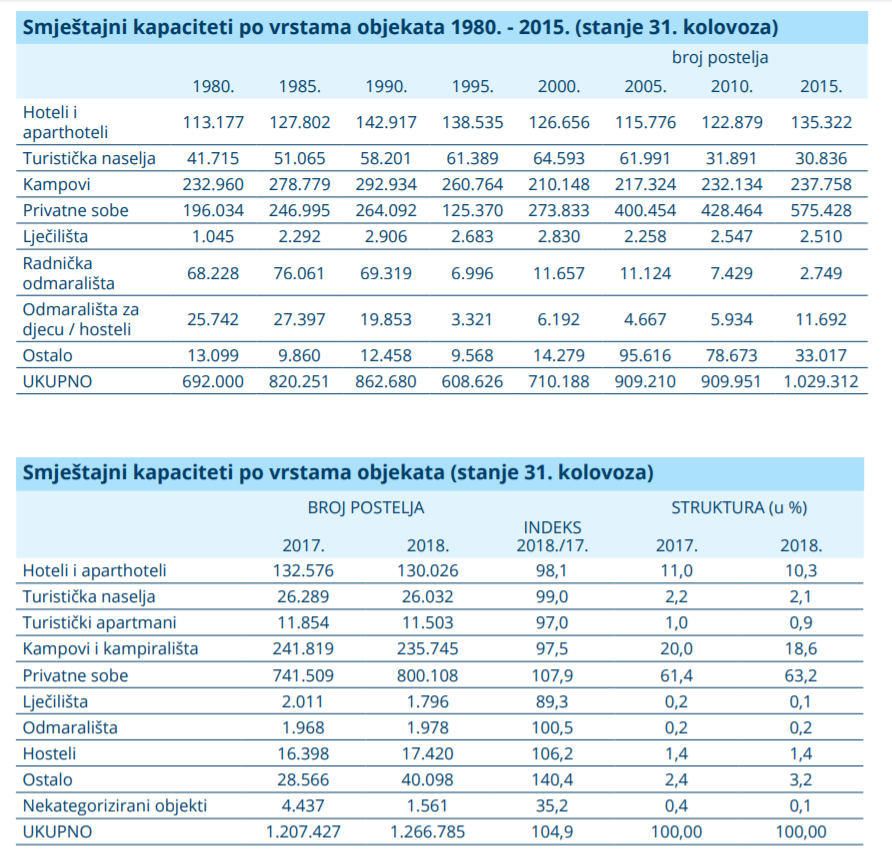
(Source: Croatian National Tourist Board)
Despite the number of overnight stays almost doubling from 1980-2019, the increase in hotel beds during that time was less than 15%, according to official figures above.
Now take a look at the change in private rooms. Less than 200,000 back in 1980, more than 800,000 in 2018, a fourfold increase in 40 years, and about double in the last decade.
So if Croatia had not embarked on its crazy expansion of private accommodation in the last decade, the 2020 numbers might well have been judged as successful with 2010 capacity. It is no secret that Croatia has way too many private beds, which is a direct result of official policy to make it much more affordable with a crazy tax incentive. (Read more in How Croatia's Tourism 'Strategy' Created Tax-Free Paradise for Private Renters). Quite how and when these 800,000 rooms will be filled again is an interesting discussion, and I am sure that the banks financing many of them will be running out of patience.
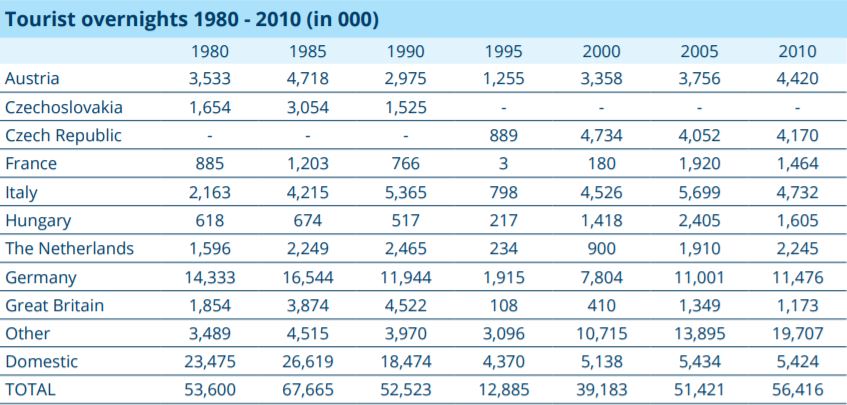
One other statistic caught my eye looking at those older statistics - the number of domestic tourists. Domestic back then of course meant the whole of former Yugoslavia, as it was before the 1991 independence. Interestingly, in 1980, this accounted for 43.7% of all tourism that year - a huge number compared to recent years.
A captive market, with many cultural connections and familiarities due to the enforced coexistence within former Yugoslavia, what was a captive market back in 1980 could easily be in 2021, especially with the current focus on destinations which are accessible by car. And yet, of the former Yugoslav republics, only Slovenia is on the radar of current tourism promotion.
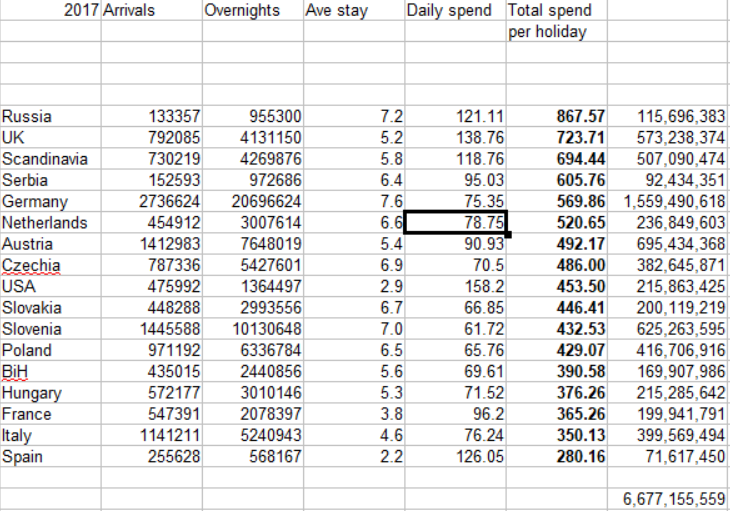
A year ago, I did some analysis on data on the 2017 tourism season, as provided to be by the Institute of Tourism. I was surprised to see that when one combines the average length of stay and average daily spend, Serbian tourists are the fourth biggest spenders on holiday in Croatia. And that Bosnians at 69.61 euro a day outspend Slovenians at 61.72 euro - I guess that has something to do with those 110,000 Slovenian holiday homes.
When I went to the Belgrade Tourism Fair a couple of years ago - the largest in the region - I was surprised that the Croatian National Tourist Board was not there. It was nothing to do with the war, as back in 2011, Croatia had been the headline sponsor of the very same trade fair. When I enquired, the national tourist board informed me that Serbia was not a strategic market. I wonder if it will/should be with the new realities.
The potential of the regional market and 2020 realities was brought home to me on a recent trip to Montenegro, where I was reporting on a complete change in strategy by the 5-star Chedi in Lustica Bay. Having been deprived not only of flights in a flight-only destination, but also with its three main markets of Germany, Russia and the UK banned from entering, the hotel had no option but to try and reinvent itself. The results have been spectacular off an admittedly much smaller base. In 2019, regional tourism accounted for just 9% of revenues for the luxury hotel, something which increased to a massive 80% this year. Most interesting is that the projections for regional revenue for 2021 are 60%. So reinvention is possible, and this is how they did it. Some lessons in there somewhere, for those who want to learn.
It is unlikely that tourism in Croatia will return to the recent past in the short term, and that is perhaps not a bad thing. But perhaps it is worth looking at tourism a bit longer ago to seeing if there are elements there that can help build a more sustainable tourism future with regional neighbours based on safety, lifestyle and authentic experiences. Perhaps some of the money we could save by reducing such a hopelessly bloated official tourism apparatus and using the funds to promote such a vision would be a greater benefit for all.
For the latest travel info, bookmark our main travel info article, which is updated daily.
Read the Croatian Travel Update in your language - now available in 24 languages.
Split Gastroadvent 2020 Kicks Off at Makarun with Vitamin D-Packed Mediterranean Menu
November 29, 2020 - The first Advent Sunday candle of Split Gastroadvent 2020 was lit by print media journalists at Makarun restaurant. Given the current corona world, a Vitamin-D-inspired Mediterranean menu was the star of the show.
Split Gastroadvent is a unique event that fuses nutrition, gastronomy, and tourism. With several years of dedicated work on gathering knowledge and skills, it reaches everyone and all parts of the world, through the image, pen, and voice of dedicated journalists, who bring light to Split in this unusual year as well.
As 2020 marks the jubilee 10th anniversary of recognizing the Mediterranean diet, this year's theme pays great attention to the sea. The Mediterranean Sea boasts an area of about 2.5 million km² and connects all countries of the original Mediterranean diet.
Following this theme, this year's Gastroadvent wreath is also dedicated to the sea and its preservation. The seafoam wreath symbolically and literally simulates the sea world and is created from discarded trash and plastic. The Mediterranean diet theme inspired prominent sculptor Nives Čičin Šain to send a message in an artistic way: “Let's preserve our sea and the life in it that feeds many with its beauty."
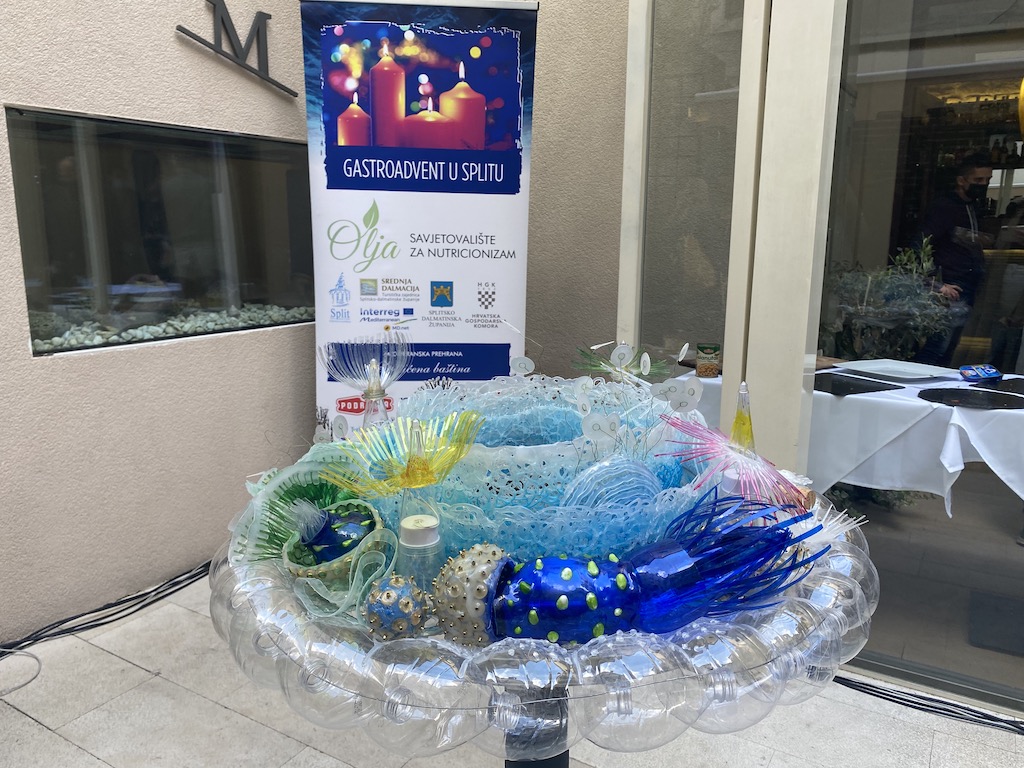
The sumptuous gastronomic table adorned dishes prepared and served according to epidemiological measures by the Makarun team. Talented Chef Ivan Planinić chose smoked mackerel with Vis capers and golden apple, amberjack filet prepared in three ways and three colors, and macaroni according to a Žrnovo recipe with spinach and a shrimp and scampi sauce.
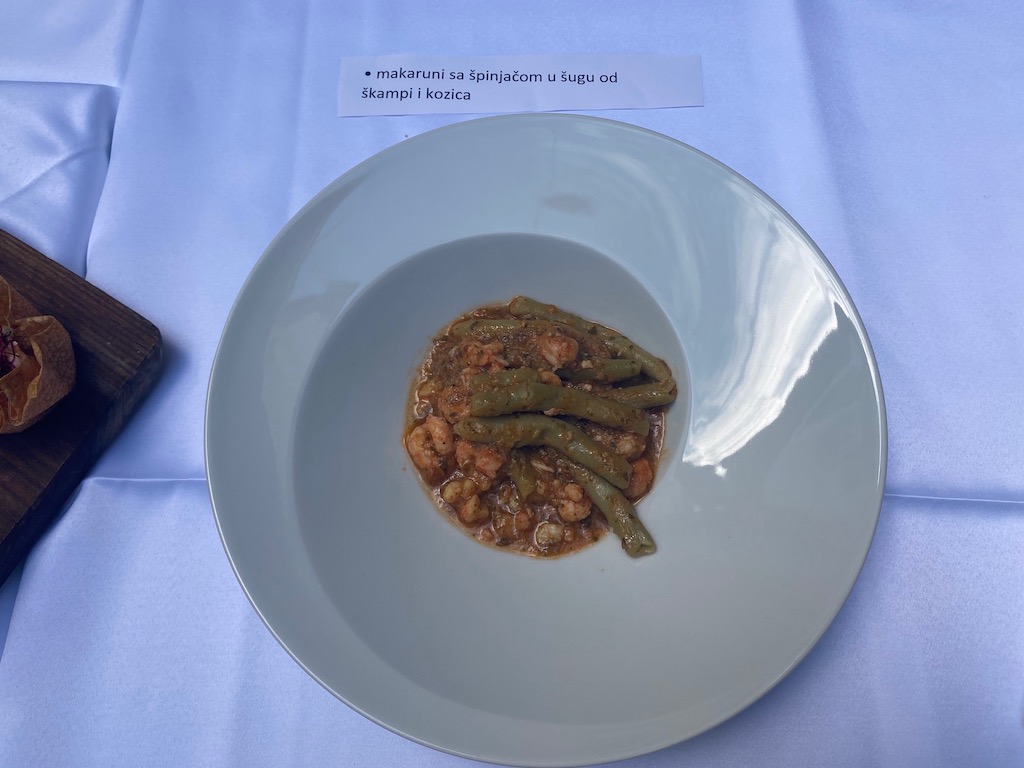
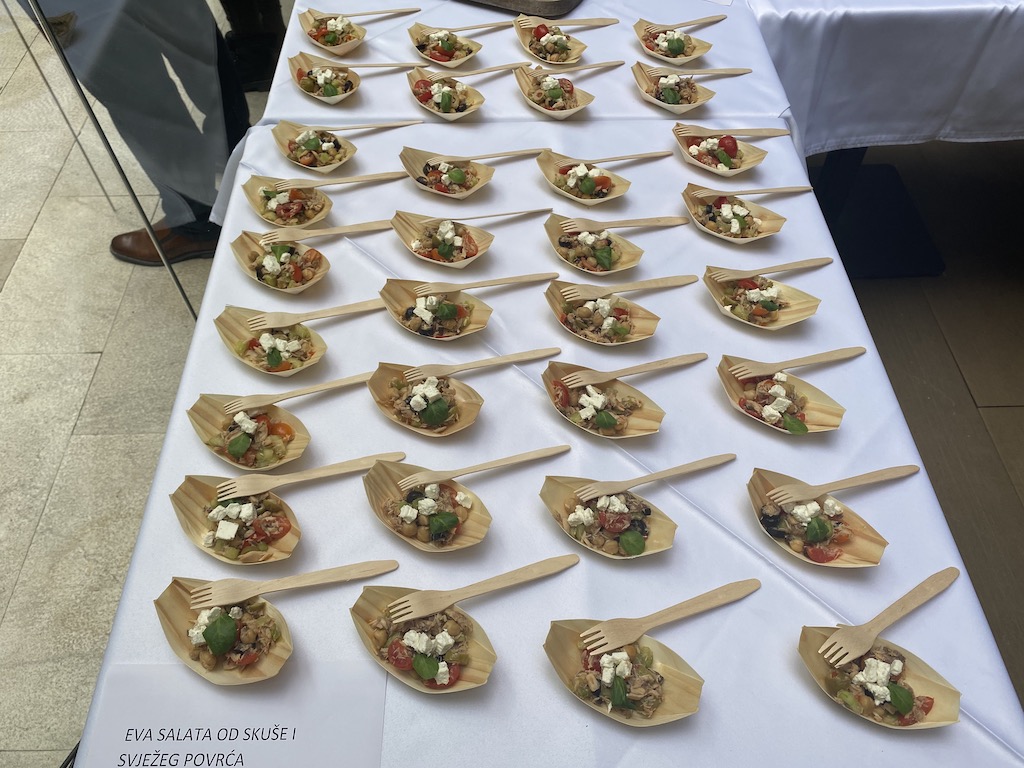
Special dishes made of fish and fish products were prepared by renowned Chef Michel Tokić from Podravka, whose knowledge and skills of cooking with EVA products are recommended especially for those who have neglected the consumption of fish and want to compensate for Vitamin D.
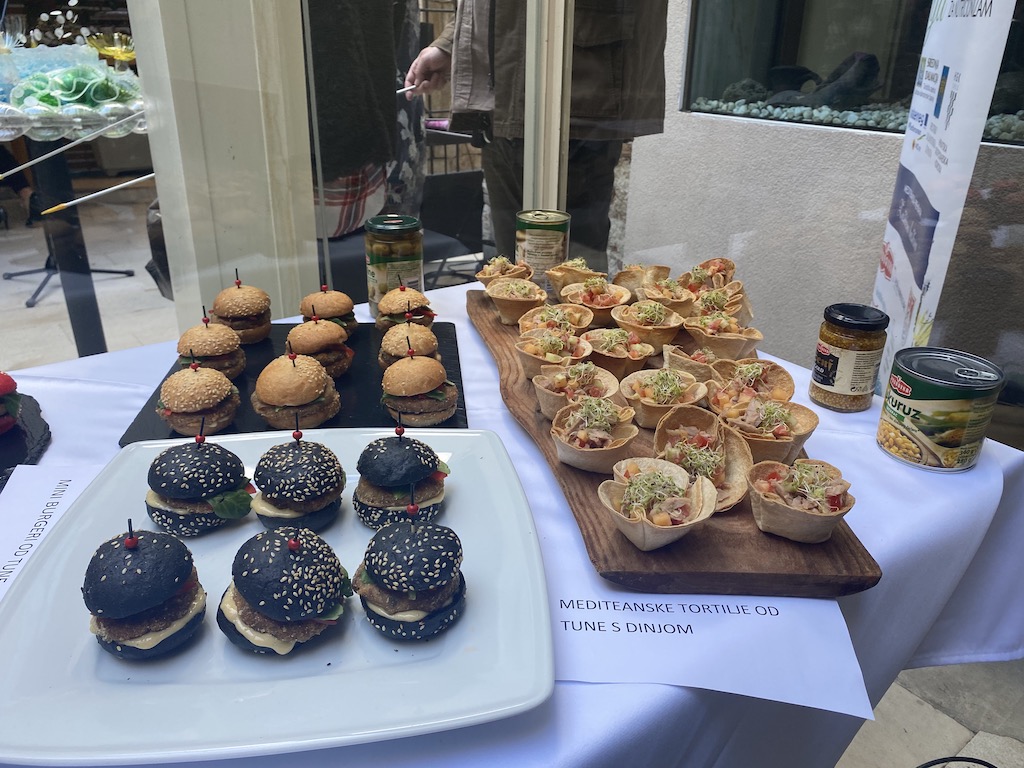
Responsible and healthy catering was presented by Michel Tokić, including Mediterranean sandwiches, Mediterranean tuna tortilla cups with melon, tuna and avocado cups, Eva salad of mackerel and fresh vegetables, and mini tuna burgers.
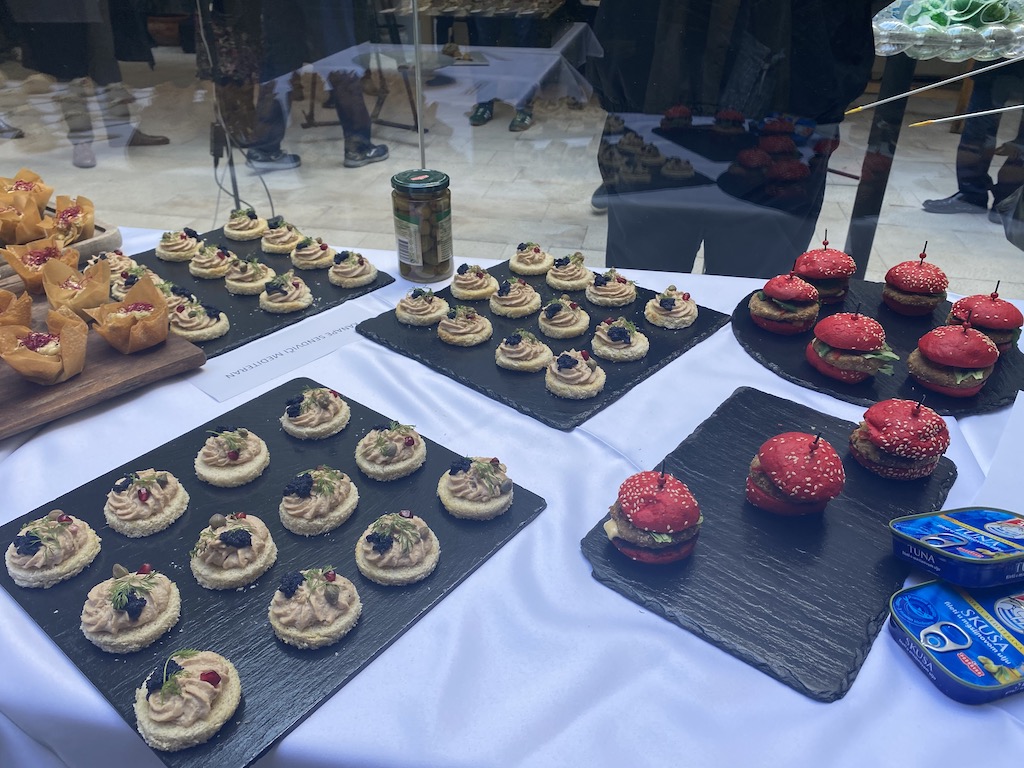
The Croatian Chamber of Commerce has been advocating for years to encourage the representation of fish on menus. For ten years now, the Croatian Chamber of Commerce has implemented the project "Croatian Fish - Eat its Worth." The project aims to increase consumption of local fish products and build and raise the culture of fish consumption in Croatia, all by raising consumer awareness of the importance and investment in sustainable fisheries, the high nutritional and health value of food originating from locally regulated catches or farming, and the importance of the product they consume from a food safety system of well-known, high standards. This project is of special importance, which was emphasized by President Jozo Tomaš, and confirmed by the cooperation with Gastroadvent in Split.
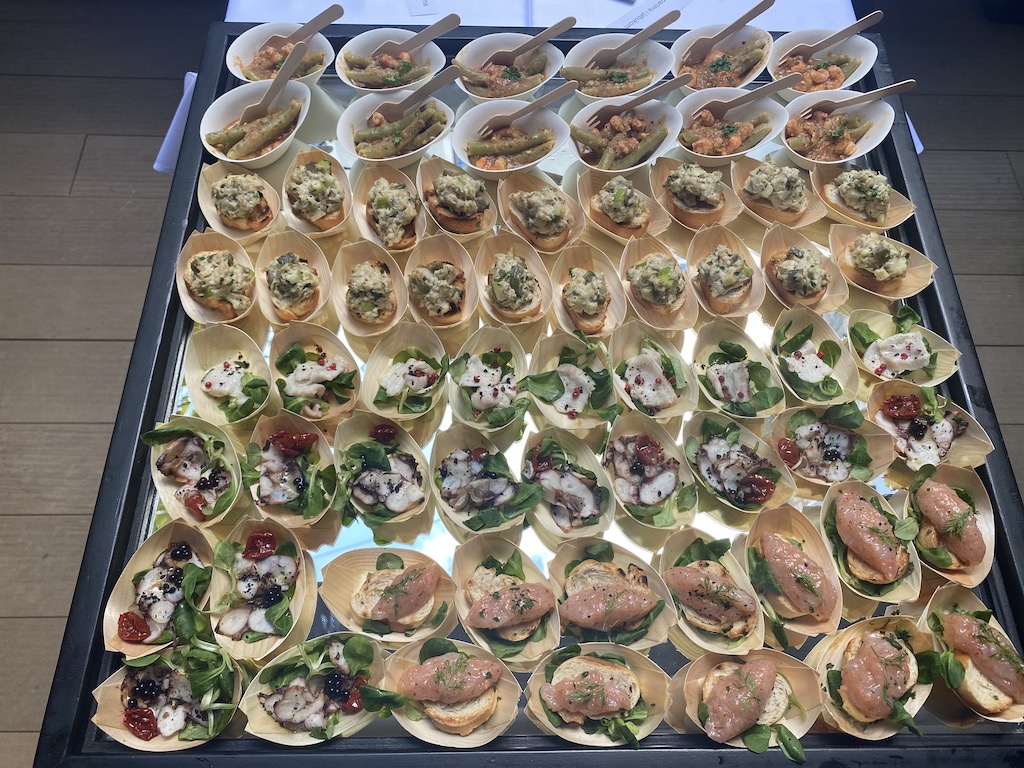
The fruits of the Adriatic Sea were presented by Gastro Ribarnica Brač, a company that makes seafood more accessible through regular campaigns, and with its professionalism guarantees safety and originality. In ten of its own fish markets in the region, in addition to fresh fish, they offer a rich selection of frozen, dried, marinated, and salty delicatessen products.
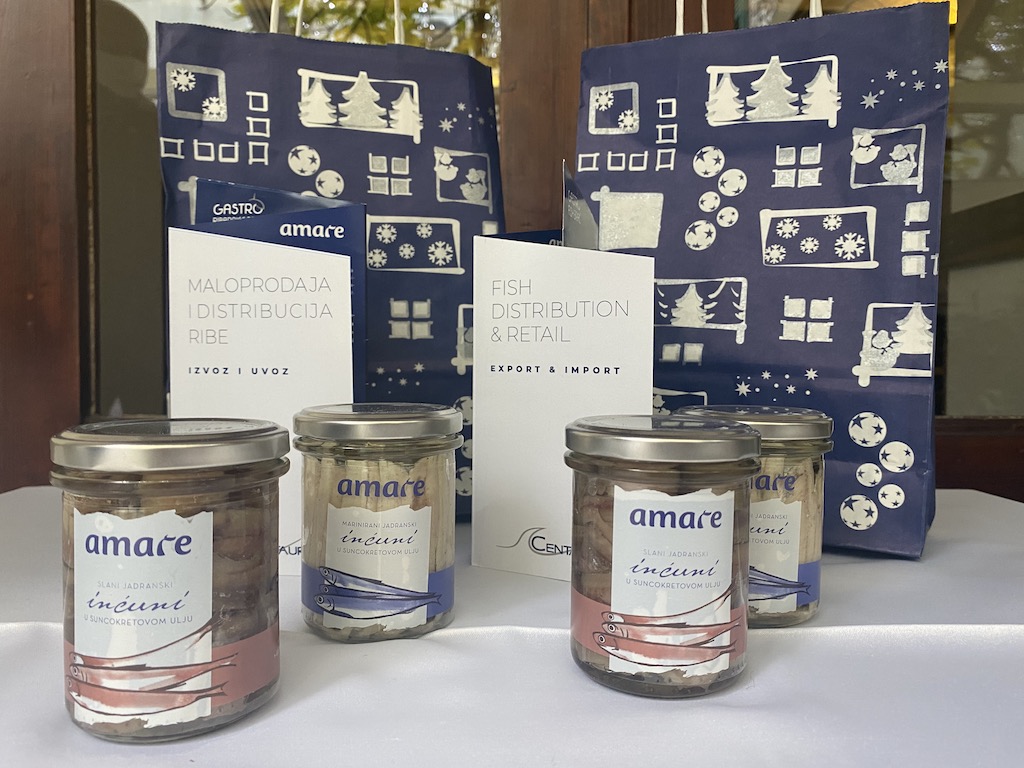
The event also highlighted ecology and competitiveness in gastronomy and tourism as the core of future projects of the Split School of Tourism and Hospitality. Under the leadership of director Ivo Bilić, the Split School of Tourism and Hospitality Management was appointed a Regional Center of Competitiveness in the summer of 2018.
An important role of the RCC is the connection to the local community, and is manifested through two goals:
1) Projects with kindergartens and primary schools in creating habits among young people and encouraging reflection on tourism, and on the other hand as promoting our professions,
2) Participation in local (regional) events, creating habits among the population about the benefits and importance of caring for the guest-tourist.
This year's Gastroadvent also features Mediterranean Food - MD.net, a project funded by the European program Interreg Mediterranean, worth 3.7 million EUR, and implemented by the Public Institution RERA S.D. for the coordination and development of Split-Dalmatia County. The project involves 14 project partners from 9 countries in the Mediterranean, which is aimed at popularizing the Mediterranean diet. The main goal of the project is to strengthen research in this area in accordance with the UNESCO Convention on Mediterranean Nutrition, to raise the quality of food and life in 9 project partner countries, as well as promote the Mediterranean diet, which is recognized as the gold standard of proper nutrition, as well as its far-reaching beneficial effects on health.
These innovative food products designed by students were presented at Gastroadvent 2020, which you can see below:
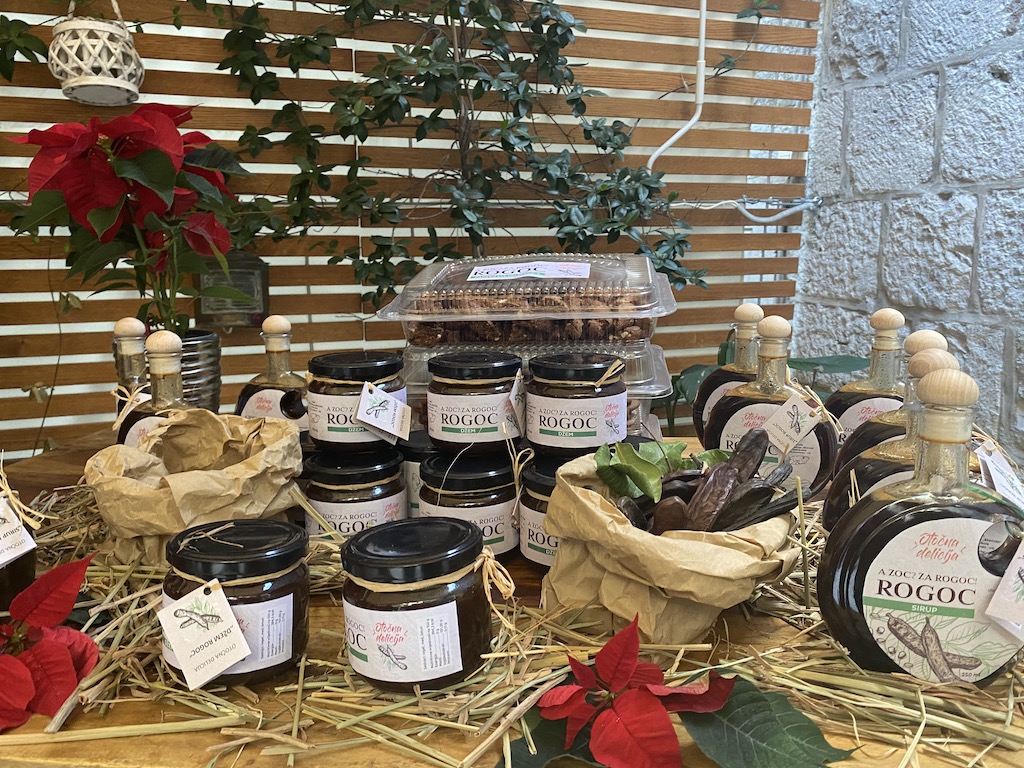
The student's mentor and workshop organizer, Michael Freer, said a few words:
"The project is working with five schools to create an innovative product. We are the end of it now, the products are ready, and each school had to use a famous Mediterranean-based ingredient from the island or their location. The idea is that with the 5,000 EUR they received through MD.net, they're able to invest in something that they can then sell. The idea is that the profit goes back into reinvesting in the student cooperative, and also hopefully to fund their dance at the end of the year, if they can have one."
Given the current circumstances, all food items were packed for guests to take home!
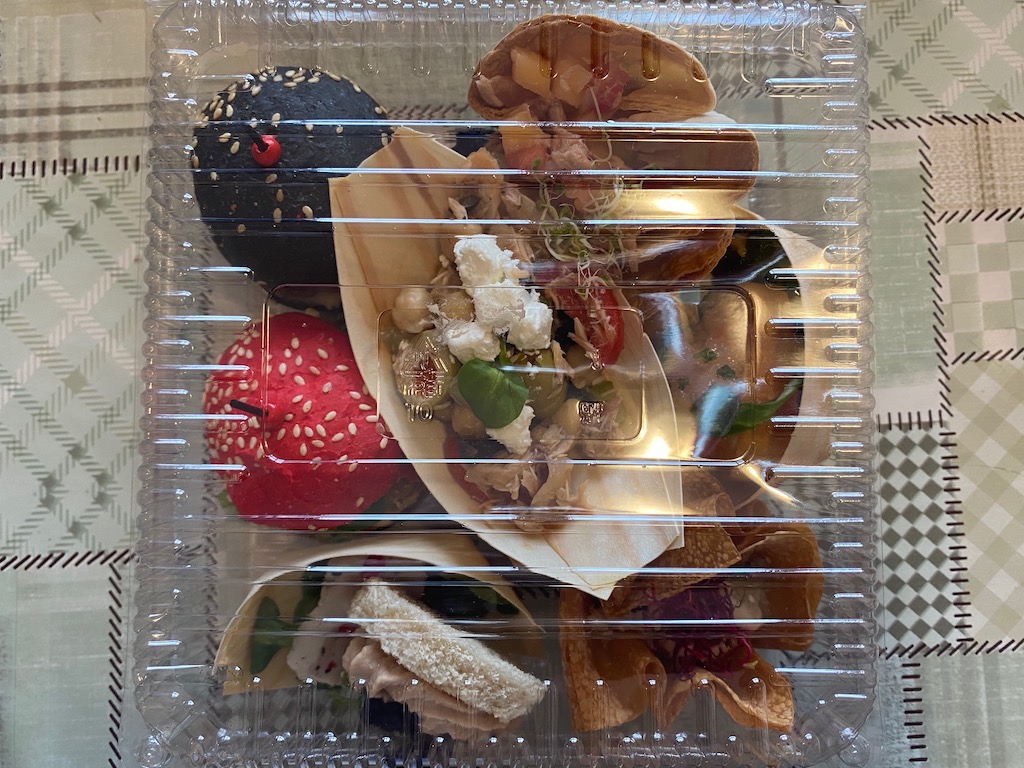
Split Gastroadvent is held every Advent Sunday at a new location!
To read more about lifestyle in Croatia, follow TCN's dedicated page.
Philosophy Faculty Osijek Croatia's First To Welcome Students' Dogs
November 29, 2020 – With most of the staff being dog owners, Philosophy Faculty Osijek has made the decision to become the first university institution in Croatia to which students can bring their pet dogs
The singular city of Osijek is well known for many reasons – the fantastic food of Slavonia and Baranja, the spectacular Old Town of Tvrđa, the Drava river along which the city stretches, one of the current top teams in the national football league and a university that produces excellent graduates in many different subjects, not least computer sciences.
In 2020, Osijek University has been earning a name for itself among the dog-lovers of Croatia. Ivana Kramer, a dog-owner and dog shelter volunteer, this year became Croatia's first animal rights lawyer after graduating from the Faculty Of Law at Osijek University. And Philosophy Faculty Osijek stands as the only such institution in Croatia that students can come to with their pet dogs.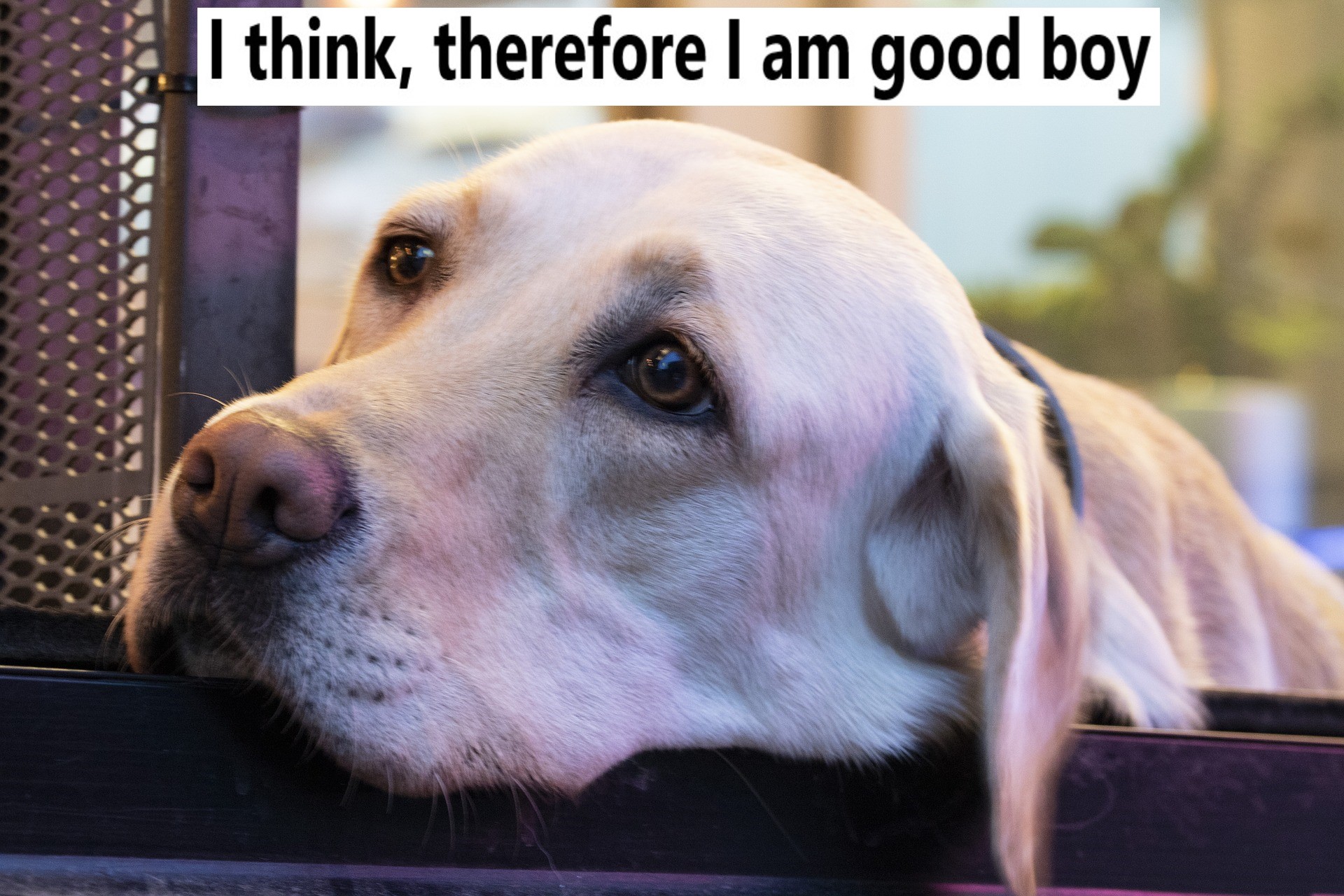
“The decision to become pet friendly was made by the Faculty Council, and according to these rules, animals entering the building must be accompanied by their owners, on a leash or in a transporter,” Vice-dean of Philosophy Faculty Osijek, Milica Lukić told Jutarnji List journalist Zrinka Korljan in an interview published 27 November. “Also, the owners at the gatehouse report the animal they are entering with, say how long they intend to stay and show an ID card. When leaving the building, they report to the gatehouse again so that we have information that the pet has left the faculty space.”
Philosophy Faculty Osijek has been allowing dogs to attend for two years now. Pets can't actually go into class with their student owners, but they can accompany them to the library. During lectures, the dogs have their own space where they can wait. Water and dog food is provided at the faculty entrance.
Other reasons prompting the decision to open the Philosophy Faculty Osijek to pets were that most of the staff were dog or cat owners and that it was noticed attendees who made short visits to the faculty were forced to tie up their dogs outside. Though the Jutarnji List interview also mentions cats in addition to dogs, no mention is made of provisions for students with more exotic pets such as snakes or tarantulas. Perhaps that's going a little too far. Being the only faculty in Croatia that welcomes dogs is maybe good enough for now.
Andrej Djukic Wants Winning Prosthetic Hand Project to be Available to Everyone
November 29, 2020 – Young Croatian product designer Andrej Djukic made the best and cheapest hand prosthesis, and thanks to this project, he recently won the Cybathlon world competition. But he does not want to stop there, as his wish is to make his hand prosthesis affordable for everyone.
As Dubrovnik.net reports, after four years of development, Andrej Djukic achieved extraordinary success with his hand prosthesis project called Maker Hand. Namely, he received the confirmation that his prosthetic hand is truly the best and most functional by winning the world competition Cybathlon, an international sports competition for people with disabilities in which the most modern prosthetic equipment is used.
In a competition between several large companies and teams of 10-30 researchers from prestigious universities, Andrej participated as an independent designer, and – won.
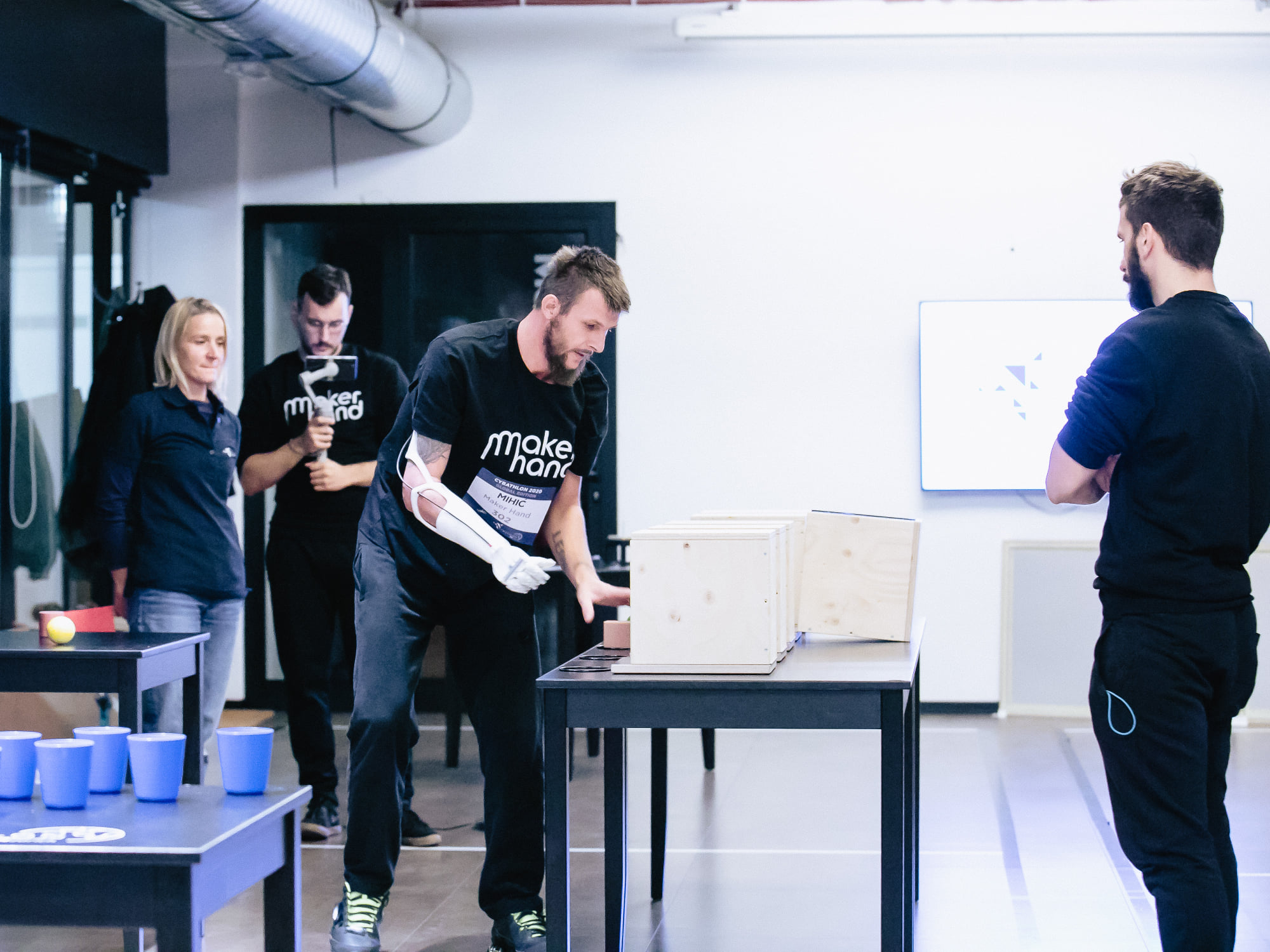
Andrej Djukic (right) with the user of his prosthesis Krunoslav Mihić at the Cybathlon competition / Source: Facebook / Copyright Marko Ercegović
This prestigious competition, which is also called a kind of Olympics for prosthetic aids, is organized by ETH Zurich, one of the highest quality tech universities in the world. It is organized every four years, and it is attended by leading companies and teams that deal with prostheses and aids from around the world, which makes the success of this young designer from Dubrovnik even more sensational.
Amazing success
As Vizkultura reports, Maker Hand won overwhelmingly in the "Powered Arm Prosthesis Race (ARM)" category. The user of the hand prosthesis with which Andrej Djukic won this year's Cybathlon is Krunoslav Mihić from Nova Gradiška.
Users of prostheses who compete with designers at Cybathlon are most often paid professionals who train for years to participate, using prostheses in their daily lives over a long period. However, Andrej was forced to change his prosthesis user a year before the competition, and with his new prosthesis user Krunoslav he had very little time to practice due to the lockdown. However, they managed to do only 40 hours of real training, so this kind of success is simply amazing.
"Among other things, in the competition, the competitor must open the jar with the mechanical hand, take a match out of the box and light a candle, turn on a light bulb, tie shoelaces, build a tower of plastic cups, fasten a jacket and sweatshirt, hammer in a nail, slice bread, and hook clips. We won convincingly and we were faster than the second-fastest team by a whole minute," says Andrej proudly.
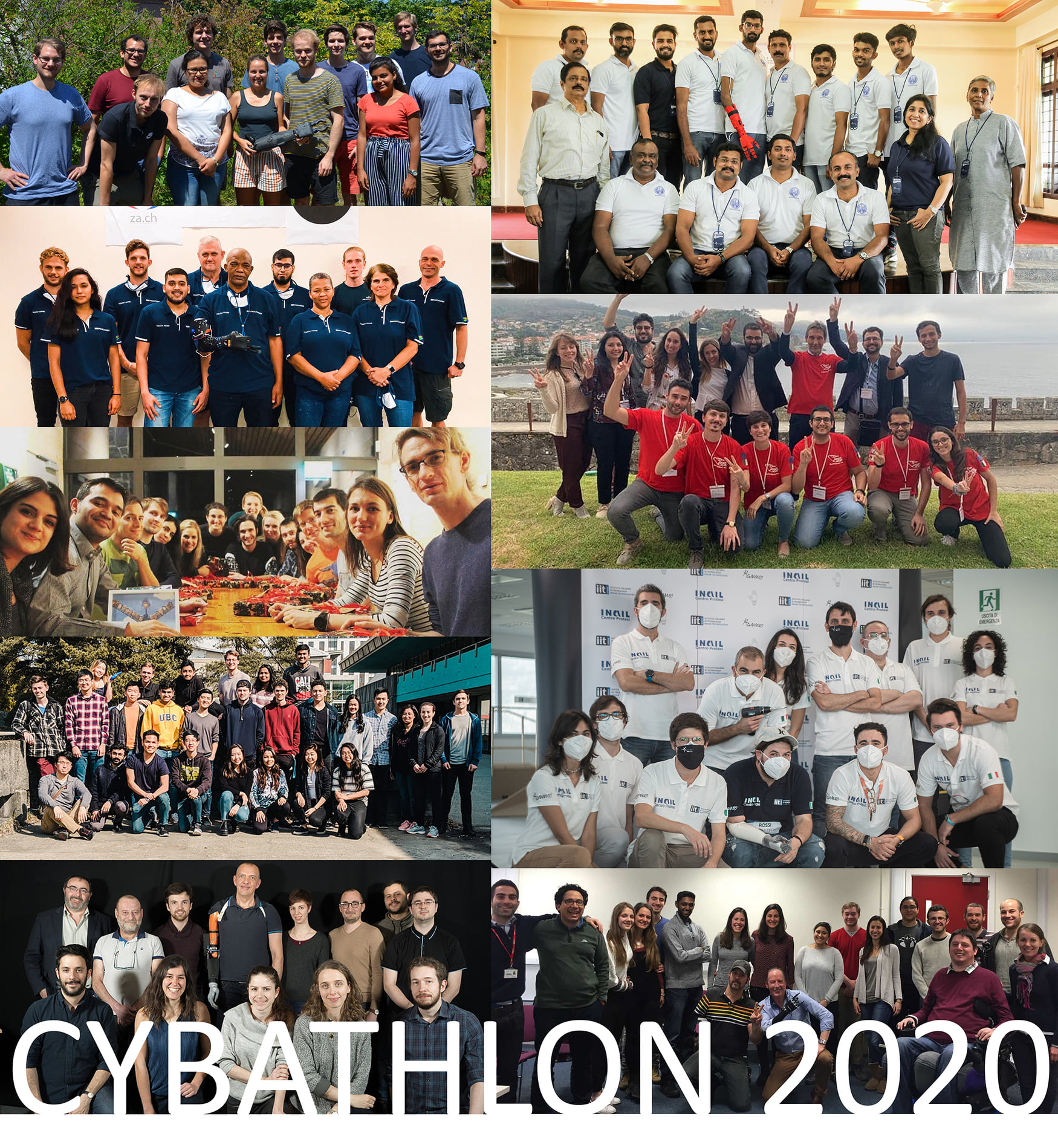
In a Facebook post, Andrej Djukic congratulated the other teams they competed against / Source: Andrej Djikic Facebook
Unlike other competitors who used advanced technologies, he used only a 3D printer for making his Maker Hand and, as he says, "the cost of parts of a single Maker Hand is less than 30 dollars and it can be assembled in a few days with a hobby 3d printer."
Durable, reliable, and affordable
Andrej was born in 1991 in Rijeka. He finished elementary school and mathematics high school in Dubrovnik, and then enrolled in the Study of Design at the Faculty of Architecture in Zagreb.
He used to design an economical and environmentally friendly furniture system, which is easy to transport, assemble and disassemble, but the furniture design did not satisfy him, so he decided to continue the study of integrated product design at the largest and oldest Dutch Technical University Delft (TU Delft).
Four years ago, Andrej suffered a chronic ankle injury through a combination of wrestling and football, which prevented him from playing sports. This prompted him to think about leg prostheses, and through independent research and learning, he came to his first functional prototype of a prosthetic hand after a year.
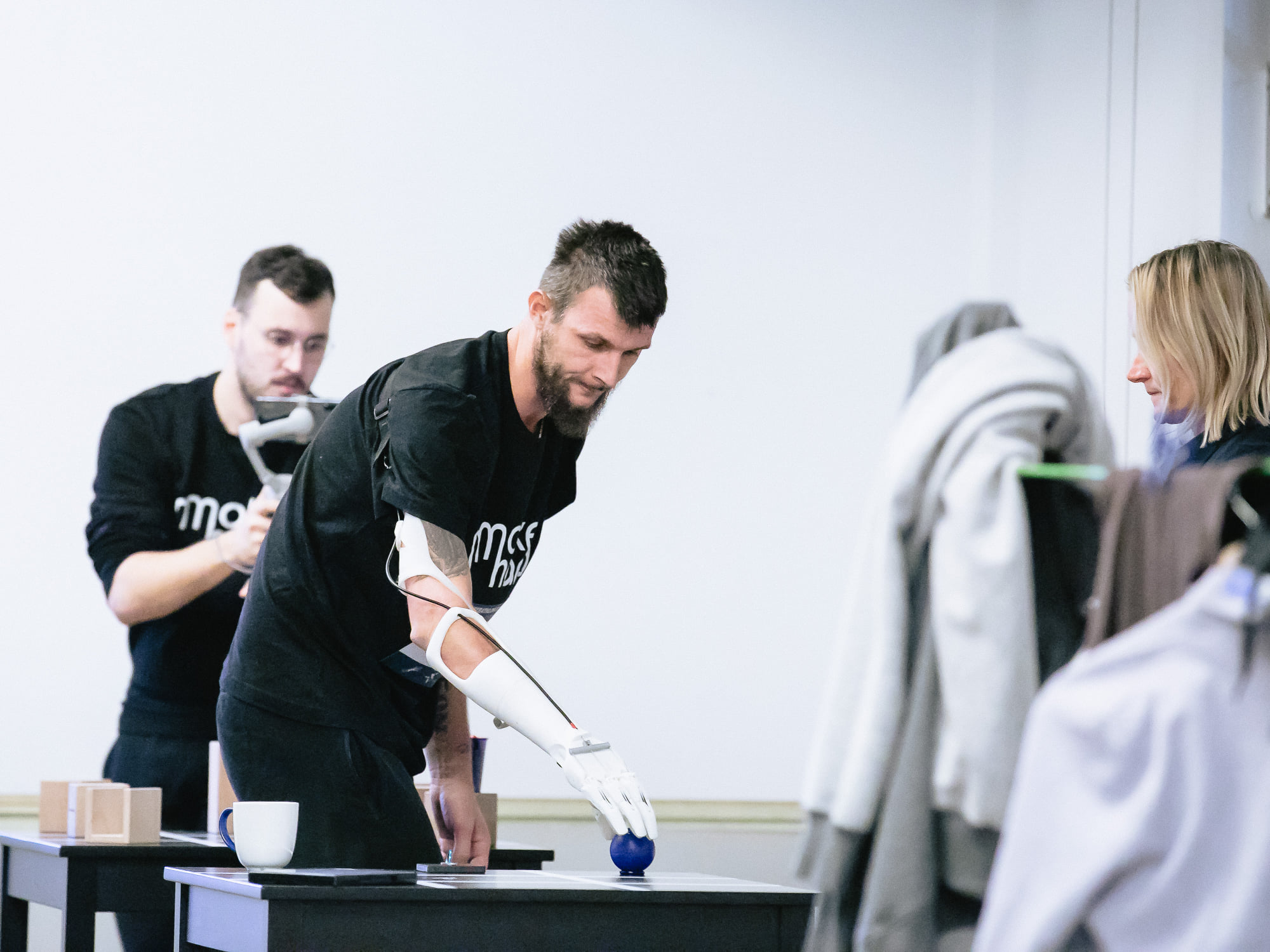
Krunoslav Mihić at the competition / Source: Andrej Djukic Facebook / Copyright Marko Ercegović
However, to make the story even better, his goal is to make the prosthesis available to everyone at minimal cost because, he believes, medicine should be free.
"I think the prices of prosthetic fists are completely insane. In general, I think that medicine should be free and that everyone should have equal access to the best medical technologies. Expensive robotic arms are difficult to control, they also need a battery, which needs to be placed somewhere, and they lack finesse. Maker Hand is very simple and functional, and is made of biodegradable plastic with the help of a 3D printer," says Andrej, who is currently realizing a global online platform that will connect volunteers, 3D model makers, and professional therapists with potential users of amputated hands, so that each of them, regardless of financial capabilities and location in the world, get a fully functional "replacement" hand for free.
With an open-source project available to everyone, Andrej wants to provide functional solutions without financial burden for prosthesis users and their families.
"The plan for the project is to gather a community of volunteer engineers/makers/prosthetists to build these hands for people who need them around the world at no cost to the amputee themselves, and also to work on improving the design to make it as durable and reliable as possible," says Andrej on his webpage.
So far, his hand has been used by three users, one of whom is Krunoslav who lost his hand in an accident at work in a factory, but also the boy Dominik Nestić, who lost both hands in the accident. Everyone is very happy and says it is the best prosthesis they have worn.
To support his work, visit his project Maker Hand page.
To read more about Croatia, follow our dedicated page.
One Man and His Dog: Outdoors Croatia Explores Seagull's Rocks and Pula Arena (VIDEO)
November 29, 2020 - The one man and dog team from Outdoors Croatia are out and about again exploring Croatia - this time Seagull's Rocks and the Pula Arena.
What is th best way to explore The Great Croatian Outdoors to find out what this wonderful country has to offer?
There are lots of websites out there and Google is your friend, but there can be few better places to start than the team from Oudoors Croatia, which started out as one man and his dog, but has recently branched out into a family journey of exploration.
As regular readers of TCN may recall, we have been featuring the excellent videos from the Outdoors Croatia team, as they seemingly cover every inch of this beautiful land, showcasing its natural beauty and adventure tourism potential. And, in these socially distanced times, perhaps there is no better time to escape the crowds and see what Croatia off the beaten path has to offer.
In the latest installment, we head to Istria, and a kayaking experience in a place I have never heard of - Seagull's Rocks - before heading to somewhere much more familiar, Pula Arena, the sixth largest Roman amphitheatre in the world. Pula Arena is, of course, one of Croatia's most unusual event locations, hosting a range of activities from rock concerts to exhibition football matches and even an ice hockey game a few years ago.
We visited The Seagull's Rocks in Pula, a very interesting area, there are beautiful beaches, small caves, it's really great. The only thing is that there were a few waves so it pushed them into the caves, it was not exactly a day to explore.
You can follow the latest from Outdoor Croatia on their YouTube channel.
For more from the TCN One Man and His Dog series, click here.
Croatian PM is Self-Isolating After His Wife Tested Positive for Coronavirus
ZAGREB, November 29, 2020 - The Croatian Prime Minister's wife, Ana Maslac-Plenkovic, tested positive for coronavirus on Saturday and after that Plenkovic himself underwent testing and his test was negative, however, he went into self-isolation, the government's public relations office reported on Saturday evening.
After a having a slightly elevated body temperature, Mrs Ana Maslac-Plenkovic underwent testing for coronavirus on Saturday and her test was positive, the government stated.
After his wife was diagnosed with coronavirus, the Prime Minister also underwent testing and his test was negative. However, the precautionary measure of staying at home for 10 days was imposed on Plenkovic and he will continue performing his duties from home, the government's spokesman Marko Milic said.


